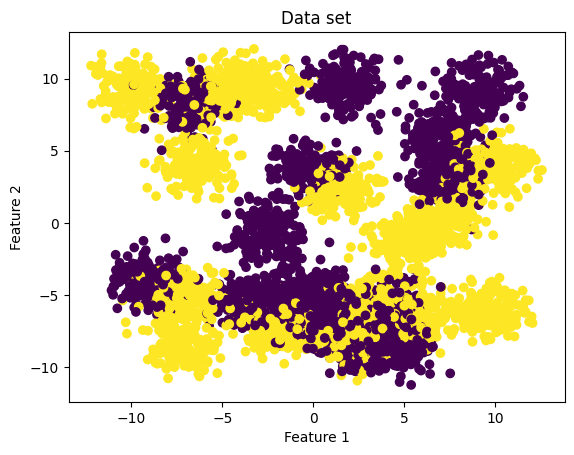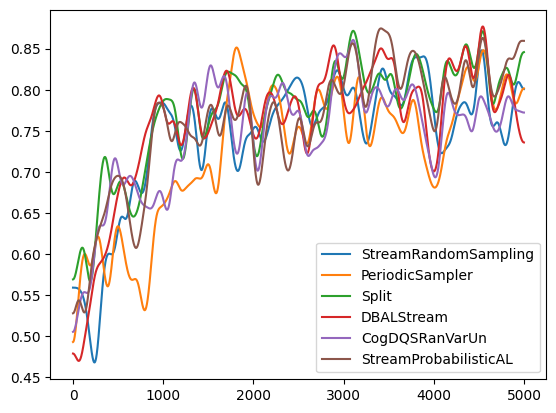Stream-based Active Learning with River#
Google Colab Note: If the notebook fails to run after installing the needed packages, try to restart the runtime (Ctrl + M) under Runtime -> Restart session.
Notebook Dependencies
Uncomment the following cells to install all dependencies for this tutorial.
[1]:
# !pip install scikit-activeml river
In this notebook, we will show how stream-based active learning strategies are used and compared them to one another. We showcase compatibility between the the methods available in the skactiveml stream package and the river library.
[2]:
import numpy as np
from collections import deque
import sklearn
import sklearn.datasets
import matplotlib as mlp
import matplotlib.pyplot as plt
from scipy.ndimage import gaussian_filter1d
from skactiveml.classifier import SklearnClassifier, SlidingWindowClassifier
from skactiveml.stream import StreamRandomSampling, PeriodicSampling
from skactiveml.stream import (
FixedUncertainty,
VariableUncertainty,
Split,
StreamProbabilisticAL,
StreamDensityBasedAL,
CognitiveDualQueryStrategyRan,
CognitiveDualQueryStrategyFixUn,
CognitiveDualQueryStrategyRanVarUn,
CognitiveDualQueryStrategyVarUn,
)
from skactiveml.utils import call_func
from river.compat import River2SKLClassifier
from river.forest import ARFClassifier
mlp.rcParams["figure.facecolor"] = "white"
Initialize Stream Parameters#
Before the experiments can start, we need to construct an artificial data set. For this, we specify the necessary parameters in the cell below. We specify the length of the data stream stream_length and the size of the sliding window that defines the available training data training_size. Additionally we define a parameter fit_clf to decide if X and y are needed and should be used.
[3]:
# number of instances that are provided to the classifier
init_train_length = 10
# the length of the data stream
stream_length = 5000
# the parameter dedicated to decide if the classifier needs to be refited with X and y.
fit_clf = False
Random Seed Generation#
To make the experiments repeatable, we will use the random_state object to generate all other random seeds, such that we only need to explicitly specify a single random seed. The get_randomseed function simplifies the generation of a new random seed using the random_state object.
[4]:
# random state that is used to generate random seeds
random_state = np.random.RandomState(0)
def get_randomseed(random_state):
return random_state.randint(2**31-1)
Generate and Initialize Data Set#
The next block initializes the tested data set. We use scikit-learn to generate a random data set with our pre-defined stream length. The data set consists of multiple parts. X represents the location of the instance within the feature space. The class for each instance is denoted by y. For models that need at least some initial training data, we generate samples to train an initial model. These are denoted by the suffix “_init”, while all data used within the active learning cycle
are denoted by the suffix “_stream”. For this notebook we evaluate the performance of each query strategy using Prequential Evaluation. If a hold-out test data set is used, it should be initialized here as well.
[5]:
X, y_centers = sklearn.datasets.make_blobs(
n_samples=init_train_length + stream_length,
centers=30,
random_state=get_randomseed(random_state),
shuffle=True)
y = y_centers % 2
X_init = X[:init_train_length, :]
y_init = y[:init_train_length]
X_stream = X[init_train_length:, :]
y_stream = y[init_train_length:]
[6]:
plt.scatter(X[:, 0], X[:, 1], c=y)
plt.xlabel('Feature 1')
plt.ylabel('Feature 2')
plt.title('Data set');
plt.show()

Initialize Query Strategies#
Next, we initialize the classifier and the base query strategies that we want to compare. To use the classifier we first need to convert the river classifier to an sklearn classifier by using their converter River2SKLClassifier. To guarantee that the classifier is not affected by previous repetitions, we use factory functions to separate the classifier for each experiment run. Since all query strategies have a default budget managager we use that for the sake of simplicity.
[7]:
classes = np.unique(y)
clf_factory = lambda: SklearnClassifier(
River2SKLClassifier(ARFClassifier()),
random_state=get_randomseed(random_state),
classes=classes)
query_strategies = {
'StreamRandomSampling': StreamRandomSampling(random_state=get_randomseed(random_state)),
'PeriodicSampler': PeriodicSampling(random_state=get_randomseed(random_state)),
# 'FixedUncertainty': FixedUncertainty(random_state=get_randomseed(random_state)),
# 'VariableUncertainty': VariableUncertainty(random_state=get_randomseed(random_state)),
'Split': Split(random_state=get_randomseed(random_state)),
'DBALStream': StreamDensityBasedAL(random_state=get_randomseed(random_state)),
# 'CogDQSRan': CognitiveDualQueryStrategyRan(random_state=get_randomseed(random_state), force_full_budget=True),
# 'CogDQSFixUn': CognitiveDualQueryStrategyFixUn(random_state=get_randomseed(random_state), force_full_budget=True),
# 'CogDQSVarUn': CognitiveDualQueryStrategyVarUn(random_state=get_randomseed(random_state), force_full_budget=True),
'CogDQSRanVarUn': CognitiveDualQueryStrategyRanVarUn(random_state=get_randomseed(random_state), force_full_budget=True),
'StreamProbabilisticAL': StreamProbabilisticAL(random_state=get_randomseed(random_state), metric="rbf"),
}
Start Active Learning Cycle#
After all, variables are initialized, we can start the experiment. The experiment loop below goes through all query strategies defined in query_strategies. For each experiment run, the average accuracy of the selected query strategies will be displayed. Lastly, the accuracy over time will be plotted.
[8]:
for query_strategy_name, query_strategy in query_strategies.items():
clf = clf_factory()
# save X and y using a sliding window
# X_train and y_train are only used for the kernel density
# estimation in StreamProbabilisticAL
X_train = deque(maxlen=1000)
X_train.extend(X_init)
y_train = deque(maxlen=1000)
y_train.extend(y_init)
# train the model with the initially available data
clf.fit(X_init, y_init)
# initialize the list that stores the result of the classifier's prediction
correct_classifications = []
count = 0
for x_t, y_t in zip(X_stream, y_stream):
X_cand = x_t.reshape([1, -1])
y_cand = y_t
correct_classifications.append(clf.predict(X_cand)[0] == y_cand)
# check whether to sample the instance or not
# call_func is used since a classifier is not needed for RandomSampler and PeriodicSampler
sampled_indices, utilities = call_func(query_strategy.query, candidates=X_cand, X=X_train, y=y_train, clf=clf, return_utilities=True, fit_clf=False)
# create budget_manager_param_dict for BIQF used by PALS
budget_manager_param_dict = {"utilities": utilities}
# update the query strategy and budget_manager to calculate the right budget
call_func(query_strategy.update, candidates=X_cand, queried_indices=sampled_indices, budget_manager_param_dict=budget_manager_param_dict)
if len(sampled_indices):
count += 1
# train the classifier
if len(sampled_indices):
clf.partial_fit(X_cand, np.array([y_cand]))
# add X_cand to X_train
X_train.append(x_t)
# add label or missing_label to y_train
y_train.append(y_cand if len(sampled_indices) > 0 else clf.missing_label)
# calculate and show the average accuracy
print("Query Strategy: ", query_strategy_name, ", Avg Accuracy: ", np.mean(correct_classifications), ", Acquisation count:", count)
plt.plot(gaussian_filter1d(np.array(correct_classifications, dtype=float), 50), label=query_strategy_name)
plt.legend();
Query Strategy: StreamRandomSampling , Avg Accuracy: 0.7456 , Acquisation count: 498
Query Strategy: PeriodicSampler , Avg Accuracy: 0.727 , Acquisation count: 500
Query Strategy: Split , Avg Accuracy: 0.7746 , Acquisation count: 523
Query Strategy: DBALStream , Avg Accuracy: 0.7606 , Acquisation count: 500
Query Strategy: CogDQSRanVarUn , Avg Accuracy: 0.7462 , Acquisation count: 521
Query Strategy: StreamProbabilisticAL , Avg Accuracy: 0.7614 , Acquisation count: 502
